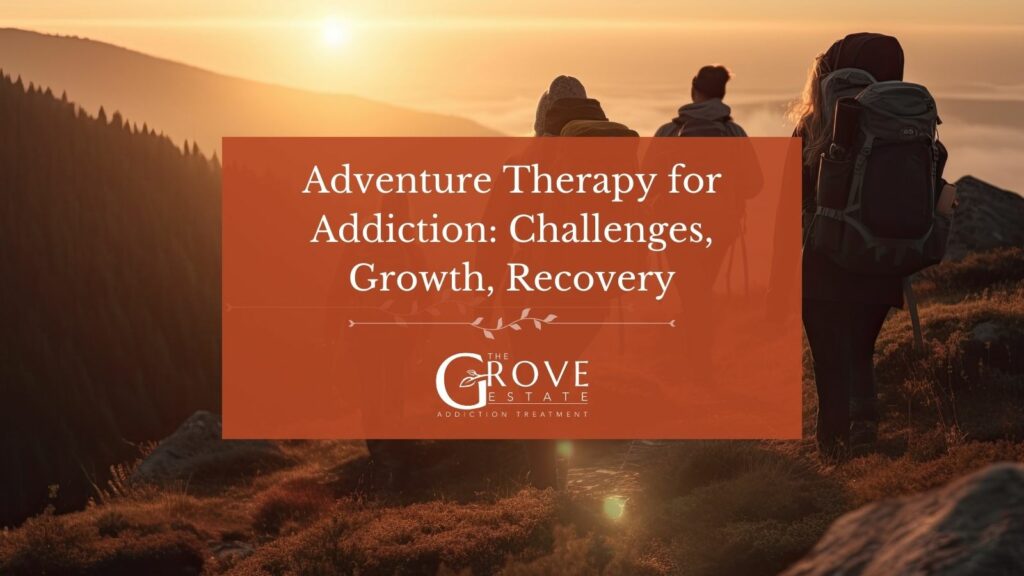Adventure therapy for addiction merges experiential activities with therapeutic processes, focusing on challenges, personal growth, and recovery in natural settings. A study published in the Journal of Experiential Education found that participants in adventure therapy programs exhibited marked improvements in self-esteem, problem-solving skills, and interpersonal relations. Additionally, a meta-analysis in “Therapeutic Recreation Journal” indicated that adventure therapy contributes to lasting behavioral change and reduces recidivism rates in substance abuse treatment.
Engaging in outdoor activities such as rock climbing, kayaking, and wilderness expeditions can create a place of self-discovery, enhance social skills, and develop coping mechanisms. These activities, under professional guidance, create therapeutic experiences that mirror life’s challenges, offering participants a unique avenue to confront their addiction, understand its underlying causes, and build resilience for sustained recovery. This therapy aligns with a holistic approach to addiction treatment, emphasizing the connection between physical activity, mental health, and emotional well-being.

What Is Adventure Therapy?
Adventure therapy is a therapeutic approach that uses outdoor activities, experiential learning, and physically engaging challenges to facilitate personal growth and emotional healing. It originated in the 1960s as a form of wilderness therapy and has since evolved to include empowering activities such as kayaking, rock climbing, caving, white water rafting, paddle boarding, bushwalking, swimming, camping, canoeing, rafting, snow camping, and skiing. The core idea is that by confronting and overcoming physical challenges in a natural environment, individuals can address psychological and emotional issues, gaining insight and resilience that can be applied to other areas of their lives.
The distinction between adventure therapy and traditional addiction treatment methods lies in its approach and setting. While traditional therapy often occurs in clinical environments and focuses on conversation-based techniques, adventure therapy takes place in outdoor settings and emphasizes experiential learning and physical activities. This approach is holistic, aiming to improve mental health through physical engagement and interaction with nature, thereby offering an alternative or complement to more conventional forms of addiction treatment.
How Does Adventure Therapy Enhance Addiction Recovery?
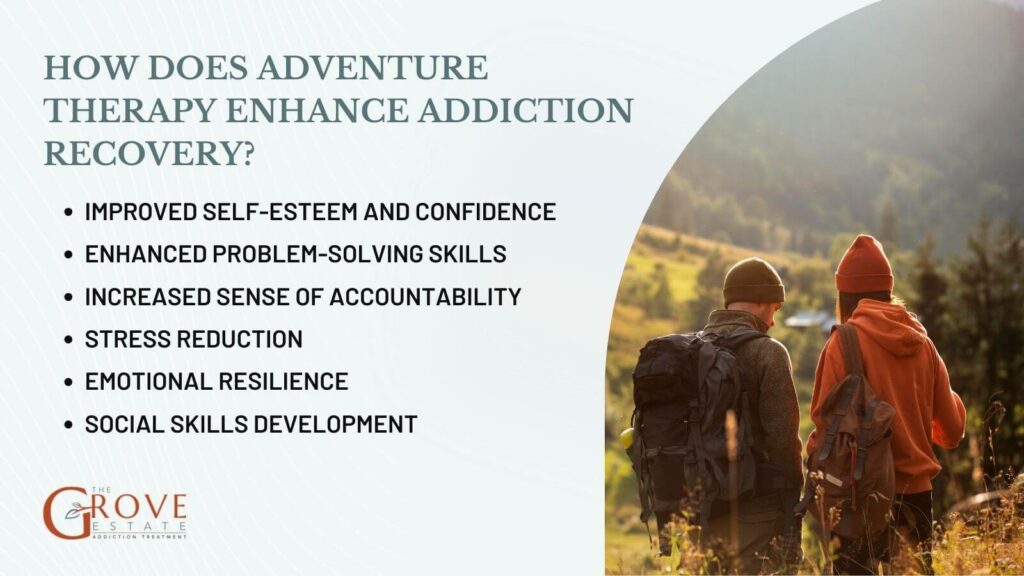
Adventure therapy boosts addiction recovery by creating feelings of accomplishment and self-worth in individuals. By combining the therapeutic process with physical and outdoor activities, an environment for personal growth and healing is manifested. Participants engage in activities which are designed to mimic life’s challenges. These experiences provide immediate, tangible obstacles to overcome, facilitating a deeper understanding of personal strengths and weaknesses, resilience, and problem-solving skills.
The specific benefits of adventure therapy in addiction recovery include:
- Improved Self-Esteem and Confidence: Successfully navigating the challenges posed during adventure activities can boost self-esteem and confidence, vital components for individuals in recovery.
- Enhanced Problem-Solving Skills: The necessity to strategize and make decisions during activities helps improve cognitive functions related to problem-solving and decision-making.
- Increased Sense of Accountability: Working in a group setting within the natural environment often requires cooperation and communication, fostering a sense of responsibility and accountability.
- Stress Reduction: Being in nature and engaging in physical activity can significantly reduce stress levels, a common trigger for substance use.
- Emotional Resilience: Facing and overcoming challenges in a controlled, safe environment can enhance emotional resilience, equipping individuals to better handle life’s stressors without resorting to substance use.
- Social Skills Development: Many adventure therapy programs involve group activities, which can improve social skills and provide a sense of community and support.
These elements contribute to a holistic recovery process, addressing not just the physical aspect of addiction, but also the emotional and psychological facets, thereby supporting a more comprehensive and sustained recovery journey.
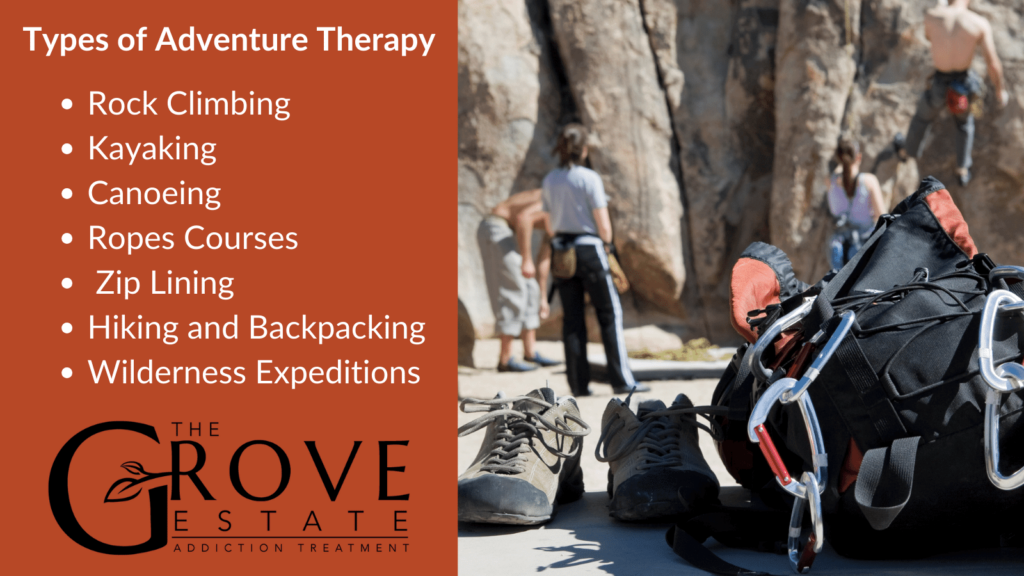
What are Different Types of Adventure Therapy Techniques and Activities?
Adventure therapy incorporates a variety of activities that challenge individuals physically and mentally, allowing for personal growth and aiding in recovery. Common activities include:
- Rock Climbing: Builds physical strength and endurance, while also teaching problem-solving, focus, and overcoming fear.
- Kayaking and Canoeing: Enhances mindfulness and stress management through rhythmic paddling and navigation, promoting a sense of calm and presence.
- Ropes Courses and Zip Lining: Develops trust, teamwork, and the ability to confront and overcome personal limitations.
- Hiking and Backpacking: Encourages reflection and connection with nature, offering opportunities for self-discovery and endurance building.
- Wilderness Expeditions: Involve extended time in nature, requiring self-sufficiency, navigation skills, and resilience, fostering independence and self-reliance.
Through these experiences, individuals in recovery can develop a stronger sense of self, improved coping mechanisms, and a supportive community, all of which are integral to a successful recovery process.
Who Benefits Most from Adventure Therapy?
Adventure therapy is most effective for individuals who prefer active learning and have not fully benefited from traditional treatment settings. This approach caters to those who need to feel and experience recovery in an active, tangible way, allowing them to embody their therapeutic journey. It suits those needing to enhance social skills, teamwork, and physical engagement as part of their recovery process.
Candidates must be physically able to participate in the activities, with adaptations available if needed. Psychological readiness is also crucial, as the therapy involves confronting personal challenges. A professional assessment is necessary to confirm if adventure therapy aligns with an individual’s specific treatment needs and health status.
Is Adventure Therapy Right for Everyone?
Adventure therapy may not be suitable for everyone, particularly those with severe physical restrictions, individuals in acute mental health crises, or those in the early stages of withdrawal from substances. People deeply entrenched in active addiction often need to stabilize medically and psychologically before engaging in the physically and emotionally demanding activities of adventure therapy.
Less physically demanding experiential treatments like art or music therapy could be more suitable for those who find intense physical activity challenging. For individuals who need a more controlled and medically supervised setting, traditional inpatient detoxification and treatment programs, individual psychotherapy, medication-assisted treatment (MAT), or support groups might provide a better fit, offering the necessary foundation and support for later transitioning to more active forms of therapy such as adventure therapy.
How Do I Integrate Adventure Therapy with Other Treatment Modalities?
Integrating adventure therapy with other treatment modalities can enhance the overall effectiveness of addiction treatment by offering a more holistic approach. Adventure therapy complements traditional treatments by providing experiential learning and physical engagement, which can deepen self-awareness and reinforce behavioral changes initiated in more conventional therapeutic settings. To integrate adventure therapy with other treatment modalities, a holistic treatment plan includes:
- Initial Medical Detox: Safely manage withdrawal symptoms under medical supervision.
- Conventional Psychotherapy: Engage in individual or group therapy sessions to address psychological aspects of addiction.
- Adventure Therapy Integration: Participate in adventure therapy activities like hiking or kayaking to enhance self-discovery and resilience.
- Ongoing Counseling or Therapy: Continue with regular counseling sessions to process experiences and sustain recovery progress.
- Support Groups: Join support groups like AA or NA for peer support and accountability.
- Relapse Prevention Education: Learn strategies to maintain sobriety and prevent relapse.
- Aftercare Planning: Develop a long-term plan for maintaining recovery, including ongoing therapy or support group participation.

What is The Role of Adventure Therapy in Dual Diagnosis Treatment?
In dual diagnosis treatment, where individuals face both substance use disorders and co-occurring mental health conditions like anxiety or depression, adventure therapy plays a crucial role. This therapeutic approach helps patients tackle their addiction and mental health challenges concurrently, utilizing physically and emotionally engaging activities such as rock climbing or wilderness expeditions. These activities provide unique opportunities for individuals to confront personal issues, learn resilience, and develop coping strategies in real-world situations.
What to Look for in a Quality Adventure Therapy Program?
When evaluating a quality adventure therapy program, key considerations include its accreditation and licensing status, ensuring it meets established standards. The qualifications and experience of the staff in adventure therapy and mental health are crucial, along with safety protocols and risk management practices.
Programs should offer individualized treatment plans, integrating adventure therapy with other therapeutic approaches for a comprehensive treatment experience. Additionally, look for evidence of the program’s effectiveness in treating similar cases, particularly for those with complex needs like dual diagnoses.
Questions to ask providers might include:
What qualifications and experience do your staff have in adventure therapy?
Favorable response: Our staff are certified adventure therapists with extensive experience in outdoor activities and therapeutic interventions.
What activities do you offer?
Favorable Response: Activities may include hiking, rock climbing, team-building challenges, wilderness excursions, and experiential learning exercises.
How are treatment plans personalized for each participant?
Favorable Response: Treatment plans are tailored based on individual needs, preferences, and goals, integrating adventure therapy with counseling, group therapy, and wellness activities.
What follow-up or aftercare support do you offer to participants post-program?
Favorable Response: We provide ongoing support through relapse prevention strategies, alumni programs, outpatient services, and referrals to community resources for sustained recovery.
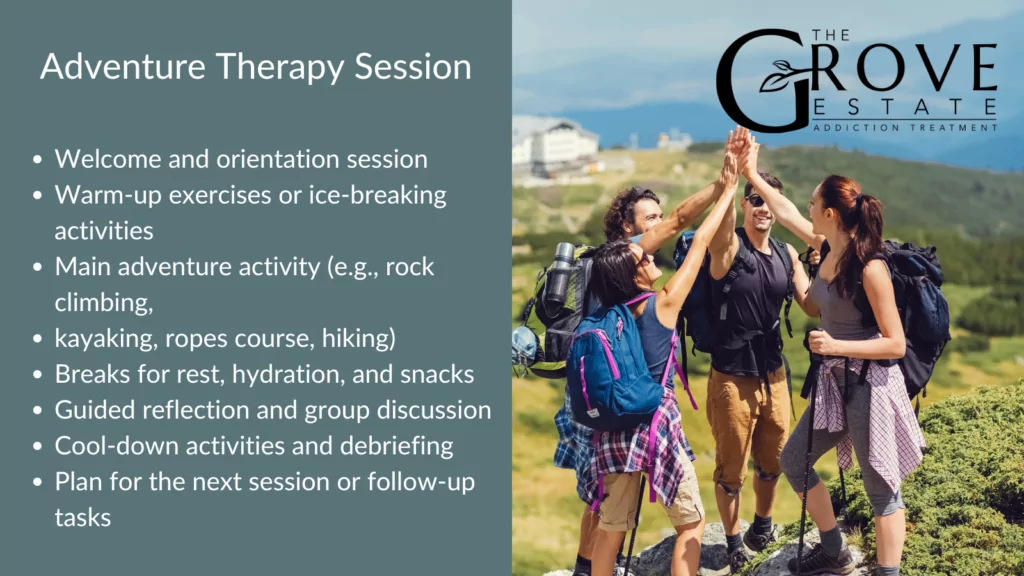
What to Expect from an Adventure Therapy Session?
A typical adventure therapy session or program itinerary varies based on the type of activity being done. Participants should prepare by dressing appropriately for outdoor activities, including wearing sturdy footwear and weather-appropriate clothing. It’s also important to be mentally prepared for the challenges ahead, maintaining an open and willing attitude to fully engage with the process. Staying hydrated, eating a nutritious meal before participating, and getting a good night’s sleep can also help individuals get the most out of their adventure therapy experience.
Here is an example of what an adventure therapy excursion would look like:
- Welcome and orientation session
- Warm-up exercises or ice-breaking activities
- Main adventure activity (e.g., rock climbing, kayaking, ropes course, hiking)
- Breaks for rest, hydration, and snacks
- Guided reflection and group discussion
- Cool-down activities and debriefing
- Plan for the next session or follow-up tasks
What are the Challenges and Considerations in Adventure Therapy?
The primary challenge in adventure therapy is ensuring the individual’s readiness and willingness to engage fully in the activities. While the inherent risks of outdoor activities and environmental factors are significant, these are typically managed through detailed planning and safety protocols. The most important aspect, however, is assessing whether participants are both physically and psychologically prepared to tackle the tasks at hand.
Qualified professionals play a major role in this, offering necessary support and guidance while ensuring safety. Comprehensive safety measures and ethical considerations, such as voluntary participation and respecting individual limits, are also imperative to the success of the therapy, supporting the participant’s engagement and the overall efficacy of the program.
What are the Benefits of Adventure Therapy at Luxury Addiction Treatment Centers?
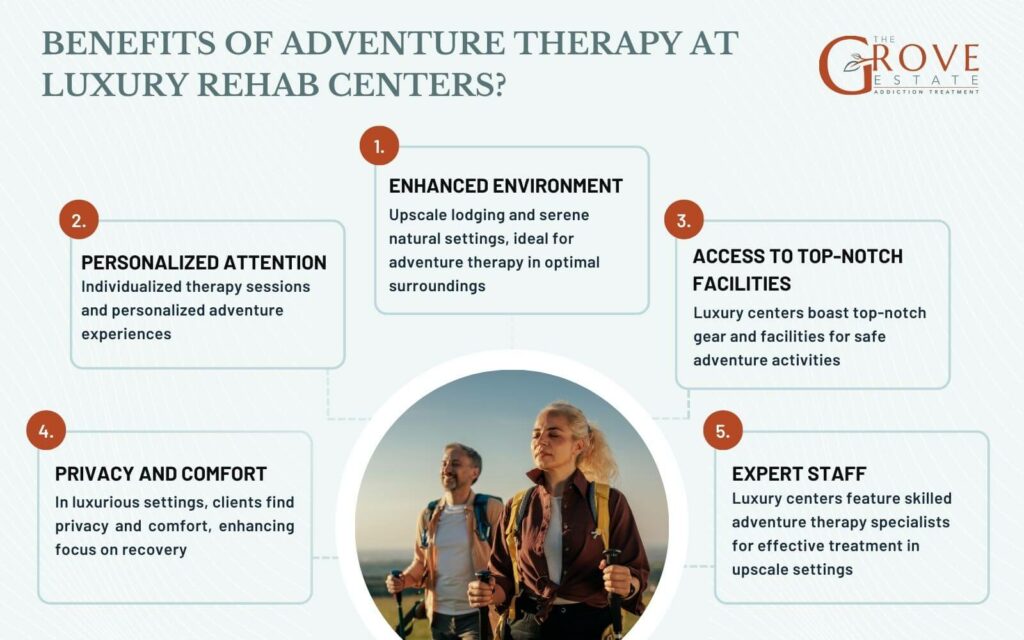
Luxury Addiction Treatment Centers have the resources available to create the best experience possible for their patients. Adventure therapy at these types of facilities offer several unique benefits:
- Enhanced Environment: Luxury centers provide upscale accommodations and serene natural settings, creating an optimal environment for adventure therapy.
- Personalized Attention: With smaller client populations, luxury centers can offer more individualized therapy sessions and personalized adventure experiences.
- Access to Top-notch Facilities: These centers often have state-of-the-art equipment and facilities for adventure activities, ensuring a safe and enjoyable experience.
- Privacy and Comfort: Clients can enjoy privacy and comfort in luxurious surroundings, allowing them to focus fully on their recovery journey.
- Expert Staff: Luxury centers typically have highly trained and experienced staff who specialize in adventure therapy, ensuring a high-quality and effective treatment experience.
What types of traditional therapies are combined with Adventure Therapy?
Adventure therapy is effectively combined with traditional therapy modalities such as Cognitive-Behavioral Therapy (CBT), group therapy, family therapy, and Motivational Interviewing (MI). These combinations create a comprehensive approach that addresses cognitive restructuring, emotional exploration, interpersonal dynamics, family relationships, and motivation enhancement within the context of outdoor experiential activities.
What are the safety precautions in adventure therapy?
Safety measures in adventure therapy include thorough risk assessments, qualified staff supervision, proper equipment usage, emergency response plans, and participant orientation on safety protocols.
How does adventure therapy address mental health issues?
Adventure therapy uses outdoor activities to promote physical activity, exposure to nature, experiential learning, teamwork, and personal growth, which can positively impact mental health and well-being.
What happens if someone is unable to participate in certain activities?
Adventure therapy programs are often adaptable to individual needs and abilities. Participants who are unable to engage in specific activities may be offered alternative options or modifications to ensure their inclusion and participation.
How long does adventure therapy typically last?
The duration of adventure therapy programs can vary widely, ranging from short-term sessions to extended programs lasting several weeks or months, depending on the treatment goals and individual needs.
How is adventure therapy different from play therapy in addiction treatment?
Adventure therapy and play therapy in addiction treatment both use experiential techniques but differ significantly in their approach and activities. Adventure therapy involves physically engaging and challenging activities in natural environments, which help participants confront physical and emotional obstacles in real-world scenarios. This method leverages outdoor activities like rock climbing, kayaking, and hiking to teach resilience, teamwork, and self-discovery.
On the other hand, play therapy in addiction utilizes a more contained and often indoor setting where activities like role-playing, arts and crafts, and sandbox play help individuals express emotions and explore personal issues in a less physically demanding way. Play therapy is particularly effective in allowing individuals to open up in creative ways, offering therapists insights into subconscious thoughts and behaviors that might influence addiction patterns.
What role does physical activity play in adventure therapy for addiction recovery?
Physical activity is a cornerstone of adventure therapy, serving multiple therapeutic functions. Engaging in physical challenges during adventure therapy helps individuals develop physical fitness and endurance, which are beneficial for overall health and well-being. Activities such as hiking or rock climbing require physical effort, which can lead to improved strength, coordination, and cardiovascular health.
Moreover, the role of physical activity extends beyond physical health, as it also contributes to mental and emotional recovery. According to research, engaging in physical activity can significantly reduce symptoms of depression and anxiety, common co-occurring conditions in addiction recovery. Adventure therapy harnesses this aspect to help participants reduce stress, improve mood, and boost self-esteem, making it a comprehensive approach to treatment. Additionally, integrating exercise and nutrition into the recovery process supports long-term health and wellness, further enhancing the effectiveness of addiction treatment.

Share This Post
